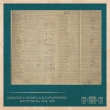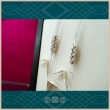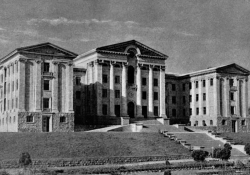In the last centenary, the Soviet Armenia, afterwards the newly created Republic of Armenia passed through a series of difficulties, and the witness and the direct participant of all that far from the city, was the building constructed instead of the vineyard on the hill, which today we know as National Assembly building. The journalist Mark Grigoryan, the grandson of the author of the building, the former Chief Architect of Yerevan Mark Grigoryan told to YEREVAN journal about the past history of the building and its present.
Far from Lenin Square
The year 1947, one summer day, the Chief Architect of Yerevan of those years Mark Grigoryan had a telephone call. The Assistant of the Head of Armenia Grigory Arutinov contacted him. He said that the Head invited him for a walk.
Bypassing the summer houses, they approached a half-empty hill, and a vineyard was in one part of it. Arutinov imagined the very place of the future building of the Communist Party Central Committee and informed Grigoryan about the idea. In his turn the architect was surprised. First of all, at that time Baghramyan Avenue was a narrow street, and along it summer houses were built, it was far from the central part of the city, Lenin Square would not even be seen from that point. How was it possible to govern the whole republic from that place? But Arutinov wanted to prove that the Communist Party could govern the country from any place.
It happened like that: Mark Grigoryan began to design the building. Only three years later the building was ready, the employees of the Central Committee – in move.
The Charm of the Light Colour
The National Assembly building embodies the best solutions of the classic architecture of those years, reminding the antique architecture and style. “This building has the charm of the light colour stone, and though they call Yerevan pink colour, at the same time they may successfully call it a terracotta colour city,” Mark Grigoryan Junior said, - imagine the architect’s skill, who could receive a traditional Greek style monumental building, which from end to end is Armenian. To doubt that that building is national, we cannot. That is the mastery.”
After a few years the National Assembly was repaired. After several decades of the construction it became clear that the building does not meet the growing bureaucratic demands, and in the mid 70s at Karen Demirchyan’s initiative new construction began. The Session Hall, the canteen, were built, and the number of the offices increased. Demirchyan’s initiated construction ended in 1985, and after three years the history took the lever in its head. Sumgait pogroms, Artsakh First war. “This building has passed through several hard event, period and public cataclysms,” Mark Grigoryan reminded, - the clouds passing over this country certainly rained on the roof of this building.”
The sufficiently weakened Central Committee had continued functioning in the building occupied the place of the vineyards, and the residence of the Supreme Council was Baghramyan 26.
From Tseka to NA
When a decision was made to reduce the influence of the Central Committee, a question arose what to do with the building, which had all facilities for the activities of the Supreme Council. However, the Communist Party had no desire to refuse its residence and proposed to the Supreme Council to occupy another building, the present American University (which, by the way, also designed Mark Grigoryan). Nevertheless, the Supreme Council was moved to “TSEKA” (Central Committee) building, which after several years was renamed National Assembly.
In the following years that building again witnessed the tragic events. In 1996, the citizens dissatisfied with presidential elections entered into the building, on October 27, 1999 one of the most tragic days of the newest history of Armenia took place, when a group of armed persons killed different members of the power. After several years, the Session Hall, where those cases happened, completed changed its look, as if wishing to forget what happened. It became more comfortable, and the rectangular edges became roundish. The journalists were moved another side of glass windows. The Hall was reopened in 2010. Anahit Tarkhanyan is the author of the new Session Hall. “In terms of architecture, unless the main look has not been distorted, and all the additions have been built from the back side, I have no problem, Mark Grigoryan Junior said.
Transformations
However, during these years, there were transformations which were not accepted by Mark Grigoryan. The external view of the pool in front of the National Assembly, mildly said, was changed and he considered it bad taste. According Mr. Grigoryan, the change made in a half-day did not correspond to the appearance of the building of the National Assembly. The pool was initially designed to provide a fire protection system. Still in the 40s, a pool was installed near every house or even on the roof of the house, so that it would be possible to use the pool in case of fire. The pool in front of the National Assembly was also planned for the same purpose – simple, water mirror at ground level. Although, it was paved, decorated with ornaments on the sides, and a metal ornament resembling a crown was placed in the centre. The complaints of the architect’s grandson were useless, the appearance remained the same.
Today, it is obvious that the building needs to be repaired, the wood windows should be changed and a number of works should be carried out. Besides that, over the years, offices became entirely different and sometimes anti-aesthetic, expressing the taste of each person working there. By the way, during his grandfather’s lifetime, Grigoryan Junior also contributed to the renovation of the building. More precisely, not to the building, but the police cabin designed near the gate which is still used as an entrance. “I was a schoolboy and one day my grandfather came home, put some variants of cabins on the table and asked which one I would choose. I said that I did not like any of them and I would prefer the combination of both variants. I drew the version of what I said on a piece of paper and gave it to him. And what? He turned it into a professional drawing and built the cabin that way,” Mr. Grigoryan remembered.
The Symbol of Trust in Authorities
A large part of the charm of the National building belongs to the surrounding park. There was also a greenhouse in the area where beautiful carnations were grown. This solution had savings goal, there was already no need to spend state money for buying flowers. After gaining independence, when the Supreme Council moved to that building, the Chairman of the Council Levon Ter-Petrosyan made a decision to open the park for the citizens. However, after weeks, the situation became uncontrollable. One day the employees came and saw that in front of the entrance of the building a coffin was placed. It turned out that a murder took place in the city and the relatives of the murdered, demanding justice, brought the coffin and placed it there. On another occasion, blankets appeared in front of the building: the people again complained. As a result of it, the park was closed again.
The park has been opened again in 2018, but today it is closed again. “I am in favor of opening the park, so that the people can enjoy it, because, after all, it is not only for a group of MPs: the park is for everyone, - Mark Grigoryan said, - but there is one circumstance. The park being open or closed became an indicator of the level of trust in the government. When the attitude is positive, the park is open, but when the attitude is negative, the park closes its doors again.
Only we’ll hope that the park will become a public place again in the near future, and the NA building will not be so far away.
 16.07.2021
16.07.2021Parliament 1918-1920: Name List of Deputies Who Received Food and Soap
The members in the parliament of the First Republic being provided food and soap were listed.“1. Aharonian Avetik2. Aghbalian Nikol3. Arghutian Hovsep.4. Araratian Sargis...
 16.07.2021
16.07.2021Parliament Protocol Museum: Wheat Ears
The Delegation members led by the Speaker of the RA National Assembly Ararat Mirzoyan being in Cyprus on an official visit brought with them and gave to the Parliament Protocol Museum a picture of wheat ears made of silver. It symbolizes the centuries-old friendship and solidarity between the Armeni...
